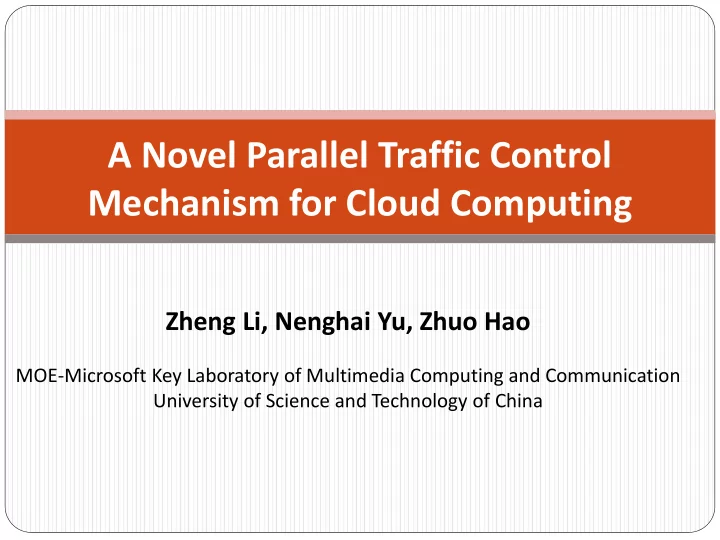

A Novel Parallel Traffic Control Mechanism for Cloud Computing Zheng Li, Nenghai Yu, Zhuo Hao MOE-Microsoft Key Laboratory of Multimedia Computing and Communication University of Science and Technology of China
Outline Introduction Weaknesses of HTB Parallel HTB Experiments
Outline Introduction Weaknesses of HTB Parallel HTB Experiments
Traffic Control in Cloud Computing Control the outbound bandwidth require an effective bandwidth management traffic scheduler & shaper Hierarchical Service idea of cloud computing different service level an attempt of customized SLAs on bandwidth A Contradiction different service levels vs. user experience a possible solution : HTB
Hierarchical Token Bucket HTB a traffic control algorithm currently implemented in Linux kernel a module of TC (Traffic Control) Basic idea bandwidth borrowing make full use of resource a solution for the contradiction hierarchical service & better user experience
CBQ vs. HTB HT HTB (AR/CR CR) CB CBQ (AR) CBQ – Class Based Queueing 1Gbps bps 1Gbps bps HTB – Hierarchical Token Bucket 400 400Mbps bps 600Mbps 600 bps 400 400/600 600Mbps bps 600 600/800 800Mbps bps bps 200 200Mbps bps 200 200Mbps bps 400 200/400 200 400 200 200/400 400 200 200/600 600 400/800 400 800 200 200Mbps 400Mbps bps Mbps bps Mbps bps Mbps bps Mbps bps [300 300] (200 200 200 200) (300 300 200 200) (100 100 200 400) (100 100 400 400) [400] HTB allows bandwidth borrowing to break AR!
Outline Introduction Weaknesses of HTB Parallel HTB Experiments
Wea Weakne nesses o s of HTB HTB Processing speed 500Mbps at most not eligible for cloud computing Reasons the inherent limitation of sequential program usage of spin-lock in kernel
Outline Introduction Weaknesses of HTB Parallel HTB Experiments
Basic Idea Lock-free FIFOs based pipelining port HTB from kernel to user space based on multi-core architecture try to eliminate necessity of using locks reduce concurrency selectively apply lock-free structures make it run in a 1-way 2-stage pipeline fashion
Eliminate Locks Basic 2 operations of HTB: enque & deque Remove htb_activate and htb_deactivate in the 2 operations Critical region is reduced to only the packet queues A tradeoff: using locks but no empty queues vs. elimate locks to parallelize HTB but might exist empty queues
Lock-free FIFOs Selectively used as the packet queue Eliminate time of lock/unlock operations Make it possible for HTB to run in a pipelined fashion We haven’t adopted the advanced cache-line distance and cache-line aggregation techniques in [1], because unnecessary Stage age2 Loc Lock-free ee FIFO Stage age1 enque enque deque deque …… …… [1] J. Giacomoni, T. Moseley, and M. Vachharajani, “Fastforward for efficient pipeline parallelism: A cache-optimized concurrent lock-free queue”, Proc. of PPoPP’08, New York, NY, USA, February 2008, pp.43-52
Outline Introduction Weaknesses of HTB Parallel HTB Experiments
Bandwidth Allocation 2 Scenarios: 1Gbps bandwidth & 2Gbps bandwidth The number of users of Scenario 2 are 2 times of that of Scenario 1 Bandwidth for a user is 0.5Mbps/1Mbps and 2Mbps/12Mbps, for common service(require low band) and special service(require high band) Trace files are used in the experiments 1G/1G TOTAL L BANDW NDWIDT DTH 125 125M/650 650M*8 US USER R GRO ROUP UP US USER … … … … … … … 2.5M/13 13M*50 50 APPLI LICA CATION … … … … 0.5M/1M 2M/12 12M
Results Exp.1 ~ Exp.4: 1Gbps. Exp.5 ~ Exp.6: 2Gbps Exp.1: all users have traffics. Exp.2: 2/3 of users have traffics Exp.3 ~ Exp.4: 64B pkt len. Exp.3: use parallel HTB, Exp.4: use HTB Exp.5 :all users have traffics. Exp.6: 2/3 of users have traffics #Pkt #Max #Min FILE #Packets #Traffic Len. Len. Len. File-1 2,397,696 782 1500 64 800 File-2 2,397,696 782 1500 64 533 File-3 9,765,925 64 64 64 800 File-4 4,795,392 782 1500 64 1600 File-5 4,795,392 782 1500 64 1067 Exp. #Trace #MPPS #Mbps #Enq. #Deq. 1 File-1 1.29 1008 0.39 0.54 2 File-2 1.29 1006 0.39 0.57 3 File-3 14.1 941 0.39 0.53 4 File-3 6.7 427 0.64 1.11 5 File-4 2.60 2033 0.39 0.54 6 File-5 2.59 2026 0.39 0.58 Parallel HTB can reach 2Gbps for common packet lengths, 300% improvement of the traditional HTB
Results Output traffic rate of the total traffic Output traffic rate of a selected user
Recommend
More recommend